Larry Smith
-
- With an Interceptor, a RHIB and a Cat Maritime Reporter, Mar 2014 #40
Two extreme AC72 foiling catamarans with wing sails went head-to-head at over 40 knots in San Francisco Bay, California. The teams were competing in the 2013 Americas Cup Challenge which took place from September 7-21, 2013.
Anyone watching the first few days of Americas Cup sailing will know that it looked like Emirates Team New Zealand had a seemingly untouchable lead – then out of the blue Oracle Team USA completed one of the greatest comebacks in sport to win the 34th America’s Cup. For anyone who has watched the rising speeds of sailing records plus the development of hydrofoil technology, this event was also bound to be a game changer for ‘power versus sail.’ Another race was on in San Francisco Bay as Chase Boats and Umpire Boats utilized gasoline and diesel engine horsepower versus the AC72 boats utilizing wind energy, aerodynamics and hydrodynamics.
The AC72 is a state-of-the-art design wind powered craft. Overall length is 86 ft. (26 m), waterline length is 72 ft. (22 m) and it has an extraordinary beam of 46 ft. (14 m). The boat only weighs 13,000 pounds (5900 kg), it has a maximum draught of 14 feet (4.4 m) and is handled by a crew of eleven.
The AC72 rises out of the water on foils and designers always expected it to sail faster than the wind. Predictions were upwind at 1.2 times the speed of the true wind and downwind at 1.6 times the speed of the true wind. But the AC72 has proved to be faster, averaging about 1.8 times the speed of the wind, with peaks slightly over 2.0 times the speed of the wind. The extreme foiling catamaran design means that AC72 racing takes place on the edge of control.
There is potential for crews to fall overboard or to require immediate attention in case of injury. Each team is allowed a Chase Boat and to provide a margin of safety these high speed craft need to not only match the race boat speeds, but to be able to exceed them.
With the wing mast / sail set up if a crew breaks something, they can’t just turn and go home, because the wing stays loaded up.
The support boat has to be able to tow an AC72 home faster than the wind speed, which can mean towing at 25 knots. The boat also needs the puling power to be able to right an AC72 after a capsize – fast.
The crews try to avoid the dangers of a capsize but it is a possibility that support teams must plan for.
Tragically in May 2013, British Olympic sailing champion Andrew ‘Bart’ Simpson died after the Swedish America’s Cup craft he was sailing capsized and broke apart in San Francisco Bay. Simpson, a 36-year-old two-time Olympic medallist, suffered multiple blows to his head and body in the accident involving the 72-ft. Artemis Racing catamaran. The San Francisco medical examiner’s report said, ‘In the moments before it capsized, the yacht was turning downwind in a so called bear-away manoeuvre while travelling at about 30 knots, with wind of about 20 knots. The front of the vessel then dipped beneath the surface, the port hull broke and inverted on top of the wing.’Most conventional power craft cannot fulfill the demanding task of supporting the 72-ft. Americas Cup catamarans that can accelerate to 40 knots in seconds. The power boat ride quality has to allow for keeping up with an AC72 for an entire day, regardless of how fast the sail boat is going or what the sea conditions are like. The objective is to have a high speed craft that does not fatigue the crew and keeps the team’s paramedic and dive crews ready for action.
This is high stakes racing with multi-million dollar investments by owners and sponsors. With money of less object than usual it is interesting to compare the various designs that the teams selected as Chase Boats. The racers also require a high performance Umpire Boat capable of following close to the action and providing instant visuals of the competition as it unfolds.
The Offshore Interceptor - America’s Cup Umpire Boat
A Willard Marine High Speed Interceptor was chosen by the Americas Cup Racing Association as the Umpire Boat for the 2013 Americas Cup. The 43-ft. (13 m) craft is powered by twin Cummins 600 hp inboard diesel engines and surface drive system. The Interceptor was developed for military use from a Scarab offshore racing design and can achieve speeds greater than 60 knots.
Willard Marine teamed up with Larry Smith of Team Scarab to develop the design. Team Scarab has a 30-year heritage of designing and building world champion offshore race boats. The Interceptor was initially prototyped in response to a request by the U.S. Navy for a high-speed combat mission boat. The 43 Assault is also ideal for intercepting and boarding boats and vessels in the open ocean. Willard worked closely with Team Scarab to refine their Deep V stepped hull design in order to meet the U.S. Navy requirements, including shock mitigation seats and light weight engines. The Interceptor also has a Supplemental Stability System (S3) that increases the stability, passenger comfort and safety of heavily loaded high speed craft. The variable geometry of the sponsons increases hull efficiency and aft buoyancy where the fuel, engine and passenger loads are.
The Rigid Hull Inflatable Boat - Oracle Racing Team USA Chase Boat
Naiad Inflatables of Newport produced two custom built 42-ft. (12.9 m) RHIBs for Oracle Racing Team USA to support the Defender AC72 Yachts. Twin Yanmar 370hp inboard engines allow the chase boat to maintain the power, agility and endurance required to support the yachts through the variable conditions of San Francisco Bay at up to 45 knots.
Naiad has a strong legacy of involvement in the Americas Cup, dating back to tenders produced for Challenge New Zealand for the 1992 event in San Diego. Naiad was the first company to develop a RHIB more than 40 feet specifically designed to carry the large fully battened mainsails, unique at the time to the IACC class of Americas Cup race yachts.
These vessels were used by Team New Zealand, which successfully challenged for and won the Americas Cup in 1995 and successfully defended the Americas Cup in 2000. In addition to Team New Zealand, two of the challengers had Naiad boats custom built for the 2000 Americas Cup. The 46-ft. (14 m) Naiad Ranger was the first shaft driven inflatable, she was custom built to tow two of Young Americas IACC yachts simultaneously. This platform spawned a whole new class of diesel shaft commercial RHIB vessels for towing and pilot boat use.
High Speed Catamaran - Emirates Team New Zealand Chase Boat
Morrelli & Melvin designed a 45-foot (13.7 m) 1,200 hp high-speed catamaran as Tender and Chase Boat for Emirates Team New Zealand AC72. The concept was developed in collaboration with ETNZ and Salthouse Boatbuilders. The ETNZ chase boat is powered by four 300hp Yamaha V6 four-stroke outboard engines and has a top speed of 58 knots.
The fiberglass hull is topped with inflatable tubes allowing it to slip in beside the AC72. The ETNZ boat includes a protected main deck cabin, head, and large storage area under the foredeck. The craft has four engines to deliver the power needed to right a capsized AC72. Running all four engines at 3,000 rpm gives 30 knots and the boat uses 100 liters of fuel an hour. The boat holds 1,700 liters of fuel which gives a range of 510 nautical miles or 17 hours running time at 30 knots.
Sitting On The Dock Of The Bay
Chris Sitzenstock gave an overview of conditions onboard the Oracle Team USA Chase Boat, “the sea state in the Bay was really everything you can imagine. A few miles outside the Golden Gate to the South Bay it can go from square six to eight-ft. waves to a mill pond. The Bay is very consistent for wind, waves and ground swell funneling through the Golden Gate Bridge. Wash from the spectator boats did not have a great effect on the race course as the Bay is so busy with commercial traffic and ferries. The particularly bad sections were usually combinations of wind against tide.”
We asked Chris whether protecting equipment (mechanics / electrical / cameras) was a reason to slow down. He replied, “the Chase Boats have to follow the racing yachts so if the equipment could not take it we had to improve equipment. We asked Chris whether protecting the human body was a reason to slow down. He replied, “the Chase Boats have to follow the racing yachts so if the human body could not take it we had to improve the human body.”
There is plenty that the military and professional fast boat sector can learn from this unique situation where craft are pushed to the limit for days and weeks. Congratulations to all the racers and support teams that made the 2013 Americas Cup an outstanding event and raised the bar for power versus sail.
The Author
John Haynes, AFNI, is a Yachtmaster Ocean and Advanced Powerboat Instructor. Subject matter expertise includes high speed craft consultancy, product development and specialist training. He is Operations Director of Shock Mitigation and founder of the RIB & High Speed Craft Directory that brings together specialist boats and equipment for the professional sector
www.ribandhsc.com(As published in the March 2014 edition of Maritime Reporter & Engineering News - www.marinelink.com)
-
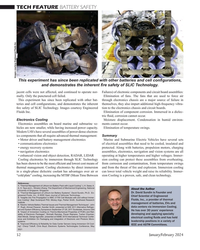 )
January 2024 - Marine Technology Reporter page: 52
)
January 2024 - Marine Technology Reporter page: 52TECH FEATURE BATTERY SAFETY Images courtesy Engineered Fluids Inc. This experiment has since been replicated with other batteries and cell con? gurations, and demonstrates the inherent ? re safety of SLIC Technology. jacent cells were not affected, and continued to operate nor- Failures) of electronic
-
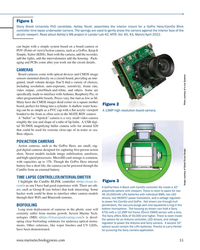 )
September 2023 - Marine Technology Reporter page: 55
)
September 2023 - Marine Technology Reporter page: 55the Arduino and Sony camera. A second 10” ments. Other solutions, like wiper brushes and UV LEDs, sphere would contain the LiPo batteries. Thanks to Larry Herbst have been demonstrated. for pursuing the Sony camera application. www.marinetechnologynews.com 55 MTR #7 (50-65).indd 55 10/2/2023 3:36:39 P
-
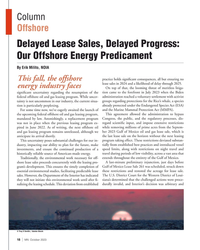 )
October 2023 - Marine News page: 18
)
October 2023 - Marine News page: 18Column Offshore Delayed Lease Sales, Delayed Progress: Our Offshore Energy Predicament By Erik Milito, NOIA practice holds signi? cant consequences, all but ensuring no This fall, the offshore lease sales in 2024 and a likelihood of delay through 2025. energy industry faces On top of that, the
-
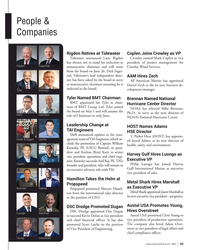 )
June 2023 - Marine News page: 43
)
June 2023 - Marine News page: 43People & Companies Rigdon Retires at Tidewater Coplen Joins Crowley as VP Tidewater announced Larry Rigdon Crowley named Mark Coplen as vice has chosen not to stand for reelection as president of project management for Rigdon Fagerstal nonexecutive chairman and will retire Crowley Wind Services. from
-
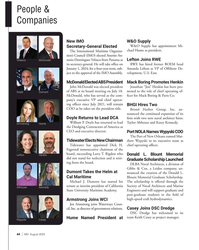 )
August 2023 - Marine News page: 44
)
August 2023 - Marine News page: 44thew Wypyski to its executive team as Tidewater has appointed Dick H. chief operating of? cer. Fagerstal nonexecutive chairman of the board, succeeding Larry T. Rigdon who Donald L. Blount Memorial Lefton Henkin did not stand for reelection and is retir- Graduate Scholarship Launched ing form the board
-
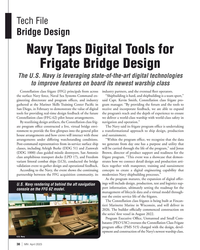 )
April 2023 - Marine News page: 38
)
April 2023 - Marine News page: 38Tech File Bridge Design Navy Taps Digital Tools for Frigate Bridge Design The U.S. Navy is leveraging state-of-the-art digital technologies to improve features on board its newest warship class Constellation class frigate (FFG) principals from across industry partners, and the eventual ? eet operators.
-
 )
April 2023 - Marine News page: 21
)
April 2023 - Marine News page: 21& Associates “Risks in terms of search and rescue are complex and very much depend on experience from real world operations, not computer models.” – Larry Wise, Senior Coastal Marine Engineer, W.F. Baird & Associates mercialization of ? oating wind energy. Interest is growing newable Energy Installations
-
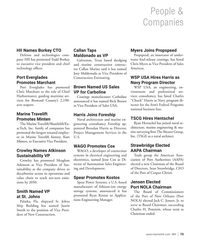 )
November 2022 - Marine News page: 73
)
November 2022 - Marine News page: 73People & Companies HII Names Borkey CTO Callan Taps Myers Joins Propspeed Defense and technologies com- Propspeed, an innovator of under- Maldonado as VP pany HII has promoted Todd Borkey Galveston, Texas based dredging water foul-release coatings, has hired to executive vice president and chief and
-
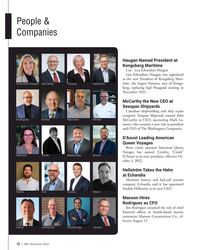 )
November 2022 - Marine News page: 72
)
November 2022 - Marine News page: 72People & Companies Haugan Named President at Kongsberg Maritime Cut Lisa Edvardsen Haugan Lisa Edvardsen Haugan was appointed as the new President of Kongsberg Mari- time, the largest business area of Kongs- Edvardsen Haugan McCarthy D’Aoust Hellström berg, replacing Egil Haugsdal starting in November
-
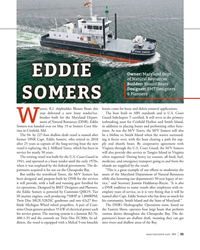 )
November 2022 - Marine News page: 55
)
November 2022 - Marine News page: 55Owner: Maryland Dept. EDDIE of Natural Resources Builder: Blount Boats Designer: BMT Designers & Planners SOMERS arren, R.I. shipbuilder Blount Boats this boom crane for buoy and debris removal applications. year delivered a new buoy tender/ice- The boat built to ABS standards and is U.S. Coast breaker
-
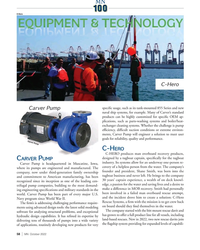 )
October 2022 - Marine News page: 58
)
October 2022 - Marine News page: 58MN C-Hero C-Hero speci? c usage, such as its tank-mounted 855 Series and new Carver Pump naval ship systems, for example. Many of Carver’s standard products can be highly customized for speci? c OEM ap- plications, such as parts-washing systems and boiler/heat- exchanger cleaning systems. Whether the
-
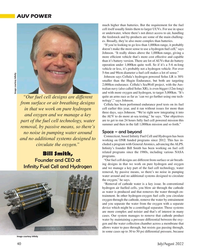 )
July 2022 - Marine Technology Reporter page: 40
)
July 2022 - Marine Technology Reporter page: 40AUV POWER much higher than batteries. But the requirement for the fuel cell itself usually limits them to larger UUVs. For use in space or underwater, where there’s not direct access to air, handling the feedstock and by-products are some of the main challeng- es. Broadly, they’re also more complex than
-
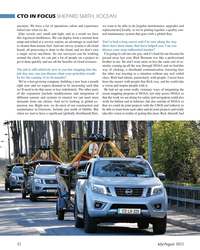 )
July 2022 - Marine Technology Reporter page: 32
)
July 2022 - Marine Technology Reporter page: 32CTO IN FOCUS SHEPARD SMITH, XOCEAN anymore. We have a lot of operations, talent and experience we want to be able to do [regular maintenance, upgrades and baked into what we do. replacements] locally, so we’re putting together a quality con- [Our vessels are) small and light, and as a result we have
-
 )
July 2022 - Marine Technology Reporter page: 30
)
July 2022 - Marine Technology Reporter page: 30CTO IN FOCUS SHEPARD SMITH, XOCEAN ty, and frankly, the biggest barrier of entry for people who could know, the deeper water for surface level multibeam scales reso- otherwise be helping with observations at sea. It’s only been lutions goes a lot faster than the shallower water. The coverage recently
-
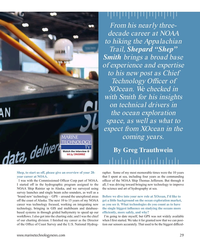 )
July 2022 - Marine Technology Reporter page: 29
)
July 2022 - Marine Technology Reporter page: 29From his nearly three- decade career at NOAA to hiking the Appalachian Trail, Shepard “Shep” Smith brings a broad base of experience and expertise to his new post as Chief Technology Of? cer of XOcean. We checked in with Smith for his insights on technical drivers in the ocean exploration space
-
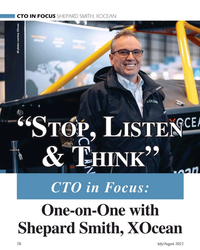 )
July 2022 - Marine Technology Reporter page: 28
)
July 2022 - Marine Technology Reporter page: 28CTO IN FOCUS SHEPARD SMITH, XOCEAN All photos courtesy XOcean “S “S , L, L TOP TOP ISTENISTEN & T& T ” ”HINKHINK CTO in Focus: One-on-One with Shepard Smith, XOcean 28 July/August 2022 MTR #5 (18-33).indd 28 6/30/2022 1:06:56 PM
-
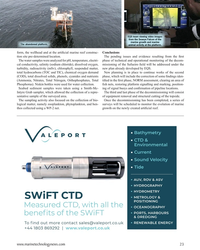 )
July 2022 - Marine Technology Reporter page: 23
)
July 2022 - Marine Technology Reporter page: 23EQ EQ EQS EQ E EQ team vie ing video imag s s s sEQS team viewingv ideoi mageses from the Seaeye Falcon of the marine growth and marine m m m Th Th he The Th he abandoned platform. T T T T Th he e abandonedp p p plat orm m m. . . fo m m. activit ity ac a mal ac an ani ani an ani animal activity animal
-
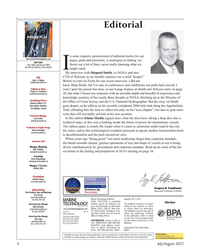 )
July 2022 - Marine Technology Reporter page: 4
)
July 2022 - Marine Technology Reporter page: 4Editorial n some respects, procurement of editorial stories for our Kraken www.marinetechnologynews.com pages, print and electronic, is analogous to ? shing: we NEW YORK throw out a lot of lines, never really knowing what we 118 E. 25th St., New York, NY 10010 Tel: (212) 477-6700; Fax: (212) 254-6271 Im
-
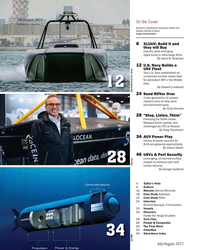 )
July 2022 - Marine Technology Reporter page: 2
)
July 2022 - Marine Technology Reporter page: 2July/August 2022 On the Cover Volume 65 • Number 5 Kraken’s SeaPower batteries ? tted into Ocean In? nity’s AUVs. Image courtesy Kraken 8 XLUUV: Build it and they will Buy Industry sees emerging opportunity in extra-large AUVs. By David R. Strachan 12 U.S. Navy Builds a USV Fleet The U.S.
-
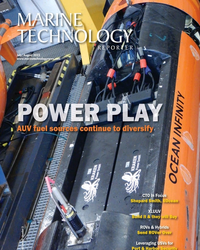 )
July 2022 - Marine Technology Reporter page: Cover
)
July 2022 - Marine Technology Reporter page: CoverMARINE TECHNOLOGY REPORTER July/August 2022 www.marinetechnologynews.com AUV fuel sources continue to diversify CTO In Focus Shepard Smith, XOcean XLUUV Build it & they will Buy ROVs & Hybrids Send ROVer Over Leveraging USVs for Volume 65 Number 5 Port & Harbor Security Marine Technology
-
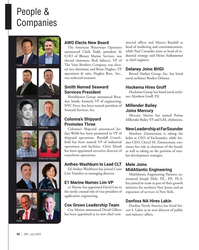 )
July 2022 - Marine News page: 41
)
July 2022 - Marine News page: 41People & Companies mercial of? cer and Marcus Randall as AWO Elects New Board The American Waterways Operators head of marketing and communications, announced Clark Todd, president & while Paul Cavander joins as head of in- COO of Blessey Marine Services, was dustrial strategy and Heinz Stalhammar
-
 )
June 2022 - Maritime Reporter and Engineering News page: 57
)
June 2022 - Maritime Reporter and Engineering News page: 57Dry Dock Conference Set for VA Corvus to open U.S. Battery Factory The tenth International Dry Dock As the maritime industry increasingly Conference is scheduled to take place moves towards propulsion solutions in Virginia Beach, VA, September that help cut emissions, battery technol- 22-23, 2022.
-
 )
June 2022 - Maritime Reporter and Engineering News page: 56
)
June 2022 - Maritime Reporter and Engineering News page: 56People & Companies of Corporate Governance, will assume the position of Chief Governance Of- ? cer, stepping into USTC Executive Management. Smith to lead Seaward Services Hornblower Group announced that Brendan Smith, formerly VP of Engi- neering, NYC Ferry, has been named President of Seaward Services
-
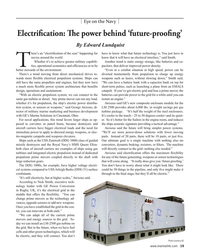 )
May 2022 - Maritime Reporter and Engineering News page: 19
)
May 2022 - Maritime Reporter and Engineering News page: 19Eye on the Navy Electrif cation: T e power behind ‘future-proof ng’ By Edward Lundquist here’s an “electri? cation of the seas” happening for have to know what that future technology is. You just have to navies around the world. know that it will have an electrical interface,” said Smith. Whether
